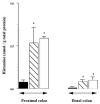Acute stress modulates the histamine content of mast cells in the gastrointestinal tract through interleukin-1 and corticotropin-releasing factor release in rats
- PMID: 14555722
- PMCID: PMC2343625
- DOI: 10.1113/jphysiol.2003.052274
Acute stress modulates the histamine content of mast cells in the gastrointestinal tract through interleukin-1 and corticotropin-releasing factor release in rats
Abstract
Stress results in activation of the hypothalamic pituitary adrenal axis and affects illnesses such as neuroinflammatory syndrome. In vivo acute stress (restraint stress) induces gastrointestinal function disturbances through colonic mast cell activation. This study investigated the effect of acute stress in histamine content of colonic mast cells, and the central role of interleukin-1 (IL-1) and corticotropin-releasing factor (CRF) in this effect. After a restraint stress session colonic segments were isolated and submitted to three protocols: (i) determination of histamine levels by radioimmunoassay (RIA) after incubation with 48/80 compound, (ii) evaluation by histology of mucosal mast cell (MMC) number and (iii) determination of histamine immunoreactivity of MMC. These procedures were conducted (1) in sham or stressed rats, (2) in stressed rats previously treated with intracerebroventricular (I.C.V.) IL-1ra or alpha-helical CRF9-41, (3) in naive rats pretreated with I.C.V. rhIL-1beta or CRF and (4) in rats treated with central IL-1beta and CRF plus alpha-helical CRF and IL-1ra, respectively (cross-antagonism reaction). Acute stress increases histamine content in colonic mast cells, without degranulation. I.C.V. pretreatment with IL-1ra or alpha-helical CRF9-41 blocked stress-induced mast cell histamine content increase. Both I.C.V. rhIL-1beta and CRF injections reproduced the stress-linked changes. I.C.V. treatment with CRF antagonist blocked I.C.V. rhIL-1beta-induced mast cell histamine content increase, whereas central IL-1ra did not affect stress events induced by I.C.V. CRF administration. These results suggest that in rats acute stress increases colonic mast cell histamine content. This effect is mediated by the release in cascade in the brain first of IL-1 and secondly of CRF.
Figures



 , stressed + saline
, stressed + saline  , stressed +α-helical CRF (20 μg kg−1
, stressed +α-helical CRF (20 μg kg−1
 , rhIL-1β (80 ng kg−1
, rhIL-1β (80 ng kg−1
 ,rhIL-1β (80 ng kg1
,rhIL-1β (80 ng kg1 , CRF (20 μg kg−1
, CRF (20 μg kg−1 , α -helical CRF (20 μg kg−1
, α -helical CRF (20 μg kg−1Similar articles
-
Stress-induced visceral hypersensitivity to rectal distension in rats: role of CRF and mast cells.Neurogastroenterol Motil. 1997 Dec;9(4):271-9. doi: 10.1046/j.1365-2982.1997.d01-63.x. Neurogastroenterol Motil. 1997. PMID: 9430796
-
Acute stress causes mucin release from rat colon: role of corticotropin releasing factor and mast cells.Am J Physiol. 1996 Nov;271(5 Pt 1):G884-92. doi: 10.1152/ajpgi.1996.271.5.G884. Am J Physiol. 1996. PMID: 8944704
-
Chronic peripheral administration of corticotropin-releasing factor causes colonic barrier dysfunction similar to psychological stress.Am J Physiol Gastrointest Liver Physiol. 2008 Sep;295(3):G452-9. doi: 10.1152/ajpgi.90210.2008. Epub 2008 Jul 17. Am J Physiol Gastrointest Liver Physiol. 2008. PMID: 18635602
-
Neuroimmune mechanisms of intestinal responses to stress. Role of corticotropin-releasing factor and neurotensin.Ann N Y Acad Sci. 1998 May 1;840:635-48. doi: 10.1111/j.1749-6632.1998.tb09602.x. Ann N Y Acad Sci. 1998. PMID: 9629290 Review.
-
Corticotropin releasing factor signaling in colon and ileum: regulation by stress and pathophysiological implications.J Physiol Pharmacol. 2009 Dec;60 Suppl 7(Suppl 7):33-46. J Physiol Pharmacol. 2009. PMID: 20388944 Free PMC article. Review.
Cited by
-
Role of probiotics in correcting abnormalities of colonic flora induced by stress.Gut. 2007 Nov;56(11):1495-7. doi: 10.1136/gut.2007.124040. Gut. 2007. PMID: 17938427 Free PMC article.
-
Effect of acute stress on immune cell counts and the expression of tight junction proteins in the duodenal mucosa of rats.Gut Liver. 2013 Mar;7(2):190-6. doi: 10.5009/gnl.2013.7.2.190. Epub 2013 Mar 14. Gut Liver. 2013. PMID: 23560155 Free PMC article.
-
Psychological stress in IBD: new insights into pathogenic and therapeutic implications.Gut. 2005 Oct;54(10):1481-91. doi: 10.1136/gut.2005.064261. Gut. 2005. PMID: 16162953 Free PMC article. Review.
-
Eosinophilic gastroenteritis: diagnosis and clinical perspectives.Clin Exp Gastroenterol. 2019 Jun 5;12:239-253. doi: 10.2147/CEG.S173130. eCollection 2019. Clin Exp Gastroenterol. 2019. PMID: 31239747 Free PMC article. Review.
-
From Hans Selye's discovery of biological stress to the identification of corticotropin-releasing factor signaling pathways: implication in stress-related functional bowel diseases.Ann N Y Acad Sci. 2008 Dec;1148:29-41. doi: 10.1196/annals.1410.007. Ann N Y Acad Sci. 2008. PMID: 19120089 Free PMC article. Review.
References
-
- Berkenbosch F, Van Oers J, Del Rey A, Tilders F, Besedovsky H. Corticotropin-releasing factor-producing neurons in the rat activated by inerleukin-1. Science. 1987;238:524–526. - PubMed
-
- Bradesi S, Eutamene H, Garcia-Villar R, Fioramonti J, Bueno L. Acute and chronic stress differently affect visceral sensitivity to rectal distension in female rats. Neurogastroenterol Motil. 2002;14:75–82. - PubMed
-
- Bradford M. Rapid and sensitive method for the quantification of microgram of protein utilizing the principle of protein-dye binding. Anal Biochem. 1976;72:248–245. - PubMed
-
- Castagliuolo I, Lamont JT, Qiu B, Fleming SM, Bhaskar KR, Nikulasson ST, Kornetsky C, Pothoulakis C. Acute stress causes mucin release from rat colon: role of corticotropin releasing factor and mast cells. Am J Phyiol. 1996;271:G884–892. - PubMed
-
- Chahdi A, Fraundorfer PF, Beaven MA. Compound 48/80 activates mast cell phospholipase D via heterotrimeric GTP-binding proteins. JPET. 2000;292:122–130. - PubMed
MeSH terms
Substances
LinkOut - more resources
Full Text Sources
Medical

